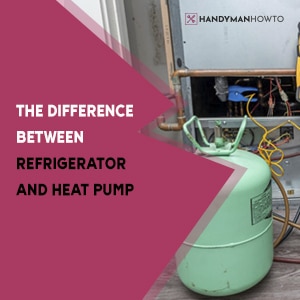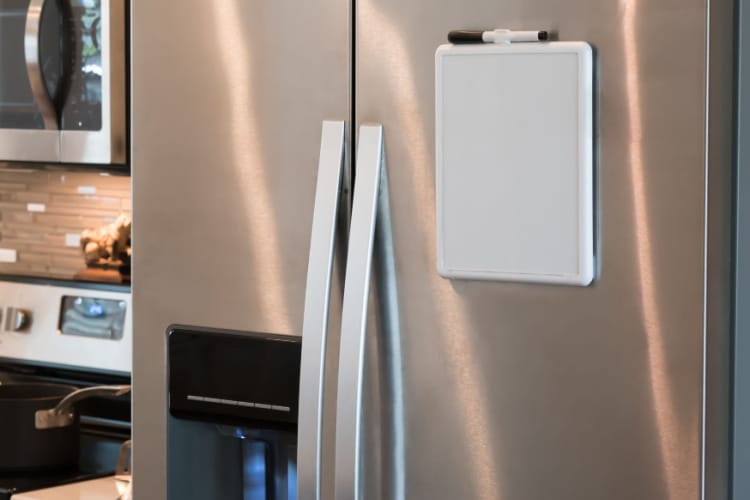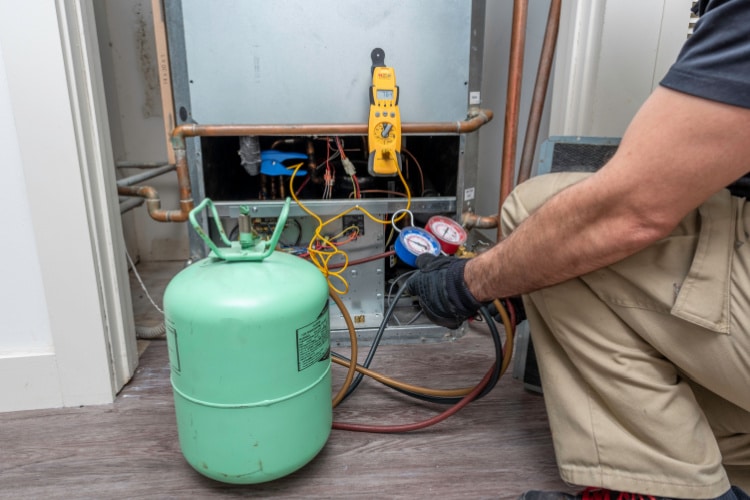Refrigerators and heat pumps are two appliances used to maintain precise temperatures in different environments.
Although they employ comparable technologies and function according to the same thermodynamic laws, these machines have considerable distinctions.
This article will examine the key distinctions between refrigerators and heat pumps, including their function, purpose, price, size, temperature range, and many other aspects.

So if you’re curious about the science behind these devices or are considering buying one for your home or business, we’ll help you get a clear grasp of how refrigerators and heat pumps differ.
The Main Difference Between Refrigerator and Heat Pump
The main difference between a refrigerator and a heat pump is the function they serve.
A refrigerator’s primary function is to cool and preserve food. On the other hand, a heat pump is designed to maintain a comfortable temperature by heating or cooling a room.
Simply put, a fridge cools down food, while a heat pump heats or cools down rooms. Let’s learn more about these appliances to understand their many distinctions better.
What Is a Refrigerator?

A refrigerator is a kitchen appliance that cools and preserves food by removing the heat from inside it and transferring it outside.
The basic components of a refrigerator include a compressor, a condenser, an evaporator, and an expansion valve — all of which help with the so-called refrigeration cycle.
The refrigeration cycle creates a continuous flow of refrigerant fluid, which removes heat from the inside chamber of the fridge and transfers it to the outside. A thermostat monitors and regulates the temperature inside and turns the compressor on and off to maintain the desired temperature range.
What Is a Heat Pump?

A heat pump is an appliance used for heating or cooling an indoor space by transferring the heat either outside the room or inside, depending on the purpose.
The basic components of a heat pump are the same as a refrigerator — a compressor, an evaporator, an expansion valve, and a condenser.
When a heat pump is used for heating, it extracts heat from the air outside or the ground and transfers it inside the building. When used for cooling, it works in reverse, removing heat from the interior of the building and transferring it outside.
Other Differences Between Refrigerators and Heat Pumps
Refrigerators and heat pumps share some similarities, such as the components used to maintain a specific temperature. However, it’s their differences that make them unique.
So far, we’ve covered their key difference, which is the purpose for which they’re used. Now let’s focus on their other differences, including their temperature range, the direction of heat transfer, size, capacity, and cost.
Temperature Range
A refrigerator is typically designed to maintain temperatures between 0°C and 5°C (32°F and 41°F), which is ideal for preserving perishable food items.
On the other hand, heat pumps can operate over a wider temperature range, depending on the type of heat pump used. Air source heat pumps maintain indoor temperatures between -13°F and 90°F (-25°C and 32°C). Geothermal heat pumps maintain temperatures between -40°F and 140°F (-40°C and 60°C). Water source heat pumps are able to keep the temperature inside the home between 45°F and 90°F (7°C and 32°C).
The Direction of Heat Transfer
In a refrigerator, the direction of the heat transfer is always from the inside of the fridge to the outside. This is because the refrigeration cycle extracts heat from the fridge’s interior and releases it into the outside environment.
In contrast, heat pumps can either extract heat from a cooler location and transfer it to a warmer location or extract heat from a warmer location and transfer it to a cooler location. To heat an area, the heat pump will remove heat from the air outside, ground, or nearby water sources and transfer it indoors. To cool a space, the heat pump will extract heat from the indoor air and transfer it outside.
Size & Capacity
Refrigerators are typically smaller than heat pumps and work at a lower capacity. They’re designed to fit in a kitchen, while heat pumps are typically larger and installed outside the building they are heating or cooling.
We mentioned that refrigerators and heat pumps share some common components, such as compressors and evaporators. However, fridges typically have a smaller compressor and a larger evaporator, while heat pumps may have a larger compressor and a smaller evaporator.
Price
Refrigerators are typically less expensive than heat pumps because they aim to keep the food cold and fresh for a long time. The average cost of a fridge ranges from $600 to $1,500, with high-end models costing up to $10,000 or more.
Heat pumps are generally more pricey because they provide both cooling and heating options, a wide range of temperatures, and a more complex installment. The average cost of an air-source heat pump system ranges from $5,000 to $8,000, while a geothermal heat pump system ranges from $10,000 to $25,000 or more. Water source heat pump ranges from $2,500 to $7,500, with high-end models costing up to $10,000 or more.
Refrigerator vs. Heat Pump Comparison Table
| Category | Refrigerator | Heat Pump |
| Purpose | To cool and keep the food and other perishable items fresh and preserved | To keep a comfortable indoor temperature by either heating or cooling a room |
| Main components | A compressor, a condenser, an evaporator, an expansion valve | A compressor, a condenser, an evaporator, an expansion valve |
| Temperature range | From 0°C to 5°C (32°F to 41°F) | Air source heat pumps: between -13°F and 90°F (-25°C and 32°C) Geothermal heat pumps: between -40°F and 140°F (-40°C and 60°C) Water source heat pumps: between 45°F and 90°F (7°C and 32°C) |
| The direction of heat transfer | Extracts heat from the interior of the fridge and releases it into the outside environment | Extract heat from a cooler location and transfer it to a warmer location, or extract heat from a warmer location and transfer it to a cooler location |
| Size & capacity | Smaller in size, have a smaller compressor and a larger evaporator, and work at a lower capacity | Bigger in size, have a bigger compressor and a smaller evaporator, and work at a higher capacity |
| Price | Cheaper, the average cost ranges from $600 to $1,500 | More expensive, air-source heat pumps range from $5,000 to $8,000, the geothermal heat pumps range from $10,000 to $25,000, whereas water source heat pumps range from $2,500 to $7,500 |
Refrigerator vs. Heat Pump: Which One to Pick?
Now that we know all the differences, which would fit your needs best?
A refrigerator is an obvious choice if you’re looking to keep your food and beverages cool. On the other hand, a heat pump is a better choice if you’re looking for an effective way to heat and cool your residence or place of business.
Conclusion
To summarize, a refrigerator cools food and beverages, whereas a heat pump provides heating and cooling for a home or business. A fridge is smaller and kept indoors, whereas a heat pump is bigger and installed outdoors. A refrigerator is also cheaper since it’s only used to store and preserve food, whereas a heat pump is more expensive because it has a wide temperature range used for both cooling and heating purposes.